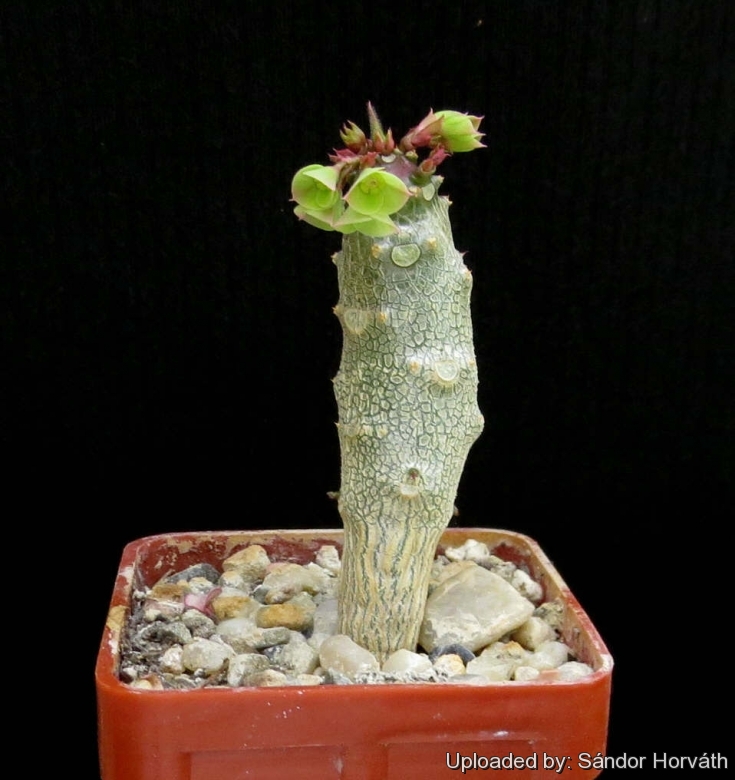




Your support is critical to our success.
Cact. Succ. 1(2): 44 (43-45; figs.). 2009 [Oct 2009]
Family: EUPHORBIACEAE

Origin and Habitat: Euphorbia maromokotrensisSN|32367]]SN|32367]] is a narrowly endemic species found in the rovince of Antsiranana in northern Madagascar (Western Indian Ocean, Africa), near the town of Maromokotra; not known elsewhere.
Habitat and ecology: This species occurs on eroded limestone hills in full sun.
Synonyms:
- Euphorbia maromokotrensis Rebmann
Description: Euphorbia maromokotrensisSN|25964]]SN|32367]], as is implied by the specific name, is a rare and localised species confined to the limestone hills of Ankarana in northern Madagascar. This is a new and poorly known caudiciform species of Euphorbia with thick fleshy stems, up to 45 cm tall and branching with age. The deciduous leaves are ovate to sub-cordate, light green with neat brown veining and are shed at the beginning of the dry season. The top of the branches produce attractive brownish-green cones of petal-like cyathophylls (Coloured bracts around the cyathium). Apparently it blooms at the end of its growth cycle so that it loses its leaves. It is one of nicest Madagascan Euphorbia, rarely found in specialized succulent collections. It was described in 2009 by Rebmann.
Stems: Erect, later creeping, branched at the base, 30-50 cm long and 8-18 mm in diameter.
Leaves: Arranged in rosette at the tip of the branches. Blade ovate to sub-cordate 8-9 cm long, to 5 cm broad, light green with neat white to brown veining above and below pubescent. Stipules very fine, divided into hair.
Inflorescences: Borne near the end of the bare stem between the tubercles erect or reclined. Cyathophylles erect, rounded, greenish brownish, c. 4 mm long, 6 mm broad.
Similar species: Euphorbia maromokotrensis closely related to Euphorbia herman-schwartziiSN|32367]]SN|25964]], bat it has slightly longer and broader leaves, branches from the base and stipules divided in bristles.
Bibliography: Major references and further lectures
1) Rebmann N. “Une nouvelle espèce d'euphorbe de Madagascar: Euphorbia maromokotrensis N. Rebmann” In: Cactus & Succulentes 1(2): 44 (43-45; figs.). 2009
Cultivation and Propagation: Little is known of Euphorbia maromokotrensisSN|32367]]SN|32367]]. It is an attractive, but slow growing species needing the typical euphorb culture with bright light, well draining substrate and watering in the growing season allowing drying between waterings. Like all the other species from Madagascar, this plant needs a temperature of at least 10°C (50°F) in winter and will do better if kept even warmer. An occasional light watering in winter will prevent excess dehydration. Rare in cultivation.
Growth rate: It is a slow growing long lived plant and once established, it will be content in its position and with its soil for years.
Exposure: A very very light and warm place in full sun is highly appreciated, but can tolerate moderate shade, and a plant that has been growing in shade should be slowly hardened off before placing it in full sun as the plant will be severely scorched if moved too suddenly from shade into sun.
Soil: It does best in a mineral soil, good drainage is essential.
Watering: Water sparingly during the summer months and keep dry in winter. In the short growing season it likes ample water and in this period it grows rather quickly, though not for a long time. When not in growth it is killed right away, when given too much water.
Frost Tolerance: Tender, it needs frost protection. Recommended minimum temperature is 12 °C or even above.
Propagation: It is propagated from seed sown during spring or summer. Germination occurs within 3 weeks. Sowing seed of this self fertile species is the surest method of growing typical offspring and seedlings are in the first season relatively easy to grow. Thanks to its freely branching habit it can be propagated by rooting cuttings of the branches. It can be grafted as well.
Warning: As with all other euphorbias when a plant get damaged it exudes a thick white milky sap known as latex. This latex is poisonous and particularly dangerous for the eyes, skin and mucous membranes. So pay extreme attention not to get any in your eyes or mouth. Cultivated plants must be handled carefully.
| Your Actions | |
|---|---|
| Back to Euphorbia index | |
| Back to Euphorbiaceae index | |
 |
Back to Succulents Encyclopedia index |
Privacy stantement - Terms and conditions - How to cite - About us - Feedback - Donate



